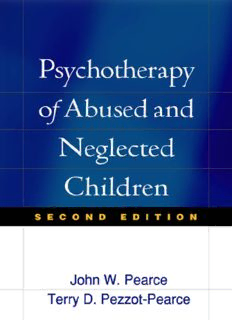
Psychotherapy of Abused and Neglected Children, Second Edition PDF
Preview Psychotherapy of Abused and Neglected Children, Second Edition
PSYCHOTHERAPY OF ABUSED AND NEGLECTED CHILDREN Psychotherapy of Abused and Neglected Children Second Edition JOHN W. PEARCE TERRY D. PEZZOT-PEARCE THE GUILFORD PRESS New York London ©2007TheGuilfordPress ADivisionofGuilfordPublications,Inc. 72SpringStreet,NewYork,NY10012 www.guilford.com Allrightsreserved Nopartofthisbookmaybereproduced,translated,storedin aretrievalsystem,ortransmitted,inanyformorbyanymeans, electronic,mechanical,photocopying,microfilming,recording, orotherwise,withoutwrittenpermissionfromthePublisher. PrintedintheUnitedStatesofAmerica Thisbookisprintedonacid-freepaper. Lastdigitisprintnumber: 8 7 6 5 4 3 2 1 LibraryofCongressCataloging-in-PublicationData Pearce,JohnW. Psychotherapyofabusedandneglectedchildren/byJohnW.Pearce, TerryD.Pezzot-Pearce.—2nded. p.;cm. Includesbibliographicalreferencesandindex. ISBN-10:1-59385-213-4 ISBN-13:978-1-59385-213-9(hardcover:alk.paper) 1.Abusedchildren—Rehabilitation. 2.Childpsychotherapy. I.Pezzot-Pearce,TerryD. II.Title. [DNLM: 1.ChildAbuse—psychology. 2.ChildAbuse—rehabilitation. 3.Child. 4.Infant. 5.Psychotherapy. WS350.2P359p2006] RJ507.A29P432006 618.92′8582230651—dc22 2006008759 AAbboouutt tthhee AAuutthhoorrss About the Authors John W. Pearce, PhD, is a staff psychologist in the Child Abuse Service at AlbertaChildren’sHospital,Calgary,Alberta,Canada.Healsoservesasthe Coordinator of Consultation Services for the local Calgary child welfare authority, and is an Adjunct Associate Professor in the Clinical Psychology ProgramattheUniversityofCalgary.Withhiswife,TerryD.Pezzot-Pearce, he coauthored Parenting Assessments in Child Welfare Cases: A Practical Guide (University of Toronto Press, 2004). TerryD.Pezzot-Pearce,PhD,isatherapistandevaluatorwhoseeschildren andparentsfromthechildwelfaresystemamongotherclinicalcases.Sheis a Practice Advisor for the Psychologists Association of Alberta and serves as a consultant to various programs and professionals regarding parenting assessments and other clinical and professional issues. Dr. Pezzot-Pearce utilizesaninterdisciplinarycollaborativelawapproachinsomecasesandis actively involved in the Round Table in Family Law in Alberta. v PPrreeffaaccee Preface T heprincipalgoalofthissecondeditionisthesameasthefirstedition’s goal: to provide a comprehensive description of strategies to assess and treat children who have suffered various types of abuse and neglect. There have been exciting and important developments in research examining the effects of maltreatment on children and what we can do to help them. In thefirsteditionwereportedthattherewerefewempiricalinvestigationsof theefficacyofinterventionscommonlyemployedwithmaltreatedchildren. Clinicians had some ideas of what might work, but evidence backing up such claims was slim. There has been a radical change: Empirically sup- ported therapies (ESTs) have received enormous attention from clinical scientists (and have generated considerable controversy). Identification of ESTsinitiallyfocusedonadultpsychotherapy,butthereisnowevidencefor the efficacy of certain treatments for children, including those who have been maltreated. Given the importance and prominence of the EST litera- ture, we review what we know about what works with abused and ne- glected youngsters. Somereadersmaydreadthatthisbookisamanualthatrigidlydictates whattodoinaprescribednumberofsessions,withouttakingintoaccount the daily demands of clinical practice with maltreated children, who often present with myriad comorbid diagnoses and who live in impoverished en- vironments with caregivers with their own complex problems. While the EST literature can teach us much, another goal of this book is to describe how ESTs can, and must, be modified to meet the unique demands of our vii viii Preface young clients and their families. Our model of clinical practice is empiri- cally informed, not empirically dictated. A further decade of treating many children and reviewing the recent literaturehasdeepenedourbeliefintheimportanceofthetherapeuticrela- tionshipforoutcome,especiallyfromtheperspectiveofattachmenttheory. The second edition offers practical recommendations for the strategic use of the relationship between the clinician and child as a principal way of promotingchange.AmajorcriticismoftheESTmovementhasbeenitsap- parentneglectofthetherapeuticrelationship.Weemphasizethattheappli- cationofESTsandafocusonthetherapeuticrelationshiparenotantitheti- cal; in fact, considerable evidence supports the notion of “empirically supported relationships” (Norcross, 2002; Shirk & Karver, 2003). Likethefirstedition,thesecondemphasizesecological,comprehensive assessments grounded in the basic tenets of developmental psychopath- ology. Evaluations not only must identify the clinically problematic behav- iors of children according to a formal nosological system (i.e., the diagno- sis), but should describe the “pathogenic processes” or mechanisms that contributetoandmaintainpathologicalbehaviors(Shirk&Russell,1996). An understanding of pathogenic processes guides treatment planning and the choice of effective interventions, in conjunction with our knowledge of the EST research and literature. As most clinicians realize, development of a treatment plan for a child based solely on evidence that a randomized control study demonstrated efficacy of certain interventions with children with the same diagnosis may not optimize outcome. For example, chil- dren’sdevelopmentalcharacteristicsareoftenpowerfulmoderatorsoftheir response to particular interventions (Grave & Blissett, 2004). Develop- mentally delayed children with little capacity to identify and articulate thoughts and cognitive processes may not do well in cognitive-behavioral therapy,despitetheresearchthatdemonstratesitsefficacyforchildrenwith certain disorders. Initiating cognitive-behavioral therapy for such children mayevenprovetobedetrimental,becausetheymayexperiencearealsense of failure and frustration, thereby exacerbating their difficulties. The second edition also includes recent developments in the assessment of children’s abuse-related attributions and appraisals and strategies to modify them. We have included more information about the assessment of attachment disorders, and highlight the prominent role of internal working models and interpersonal schemas as significant pathogenic pro- cesses and targets of intervention. The last decade has witnessed more clinical and research attention directed to sexual behavior problems and posttraumatic stress disorders of maltreated school-age children, and this edition offers an expanded discussion of relevant assessment and inter- vention strategies. Preface ix Our discussion focuses exclusively on individual therapy. We do not dismiss the utility of other psychotherapeutic approaches, especially group therapy for victimized youngsters and family therapy. Space limitations, as well as our own relative lack of expertise with these other interventions, precludeadescriptionofthesemodalities.Wedescribefamilyinterventions designed to complement and support individual child psychotherapy, but we spend no time discussing interventions designed to help abusive or ne- glectful caregivers develop healthier parenting practices. The book is intended for clinicians who work with preadolescent school-agechildren,althoughafewofthecaseexamplesincorporatemate- rial from sessions with young adolescents. Given this focus, we have de- letedourpreviousdiscussionsofparent-basedinterventionsforinfantsand toddlers, such as infant–parent psychotherapy.
Description: